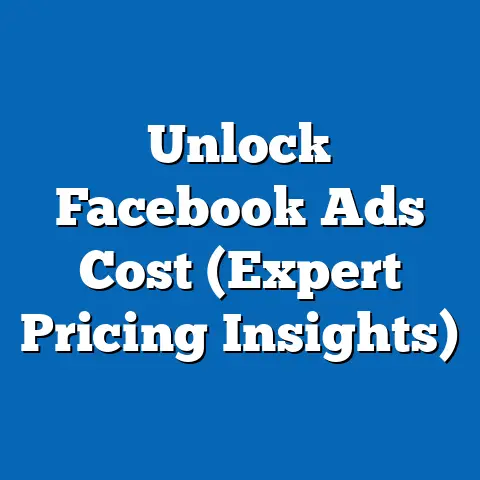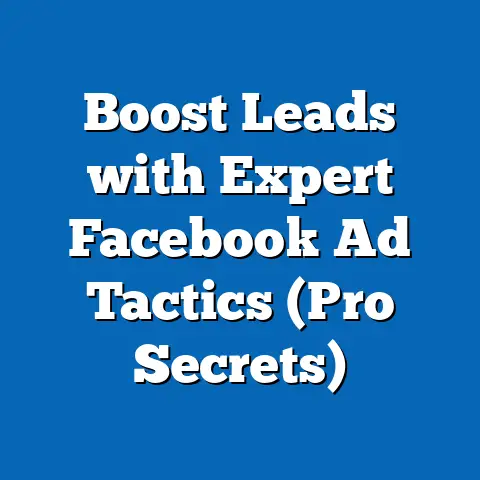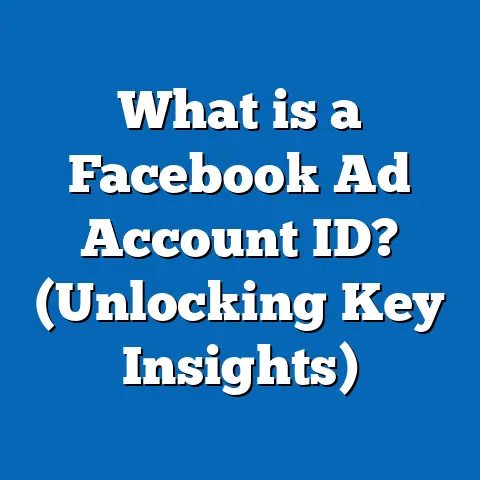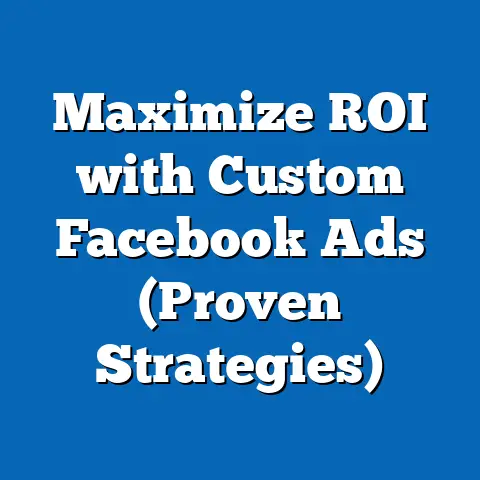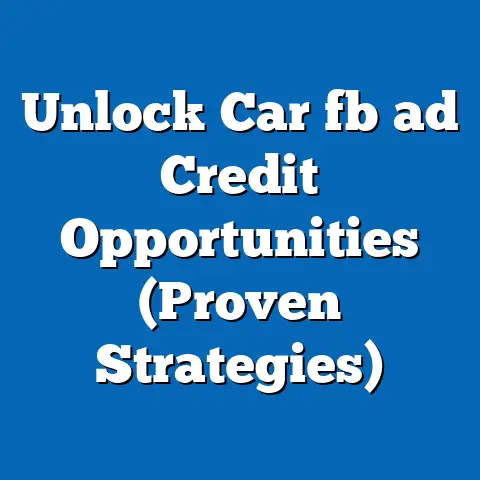Optimal Facebook Ad Posting Days (Insider Secrets Revealed)
Would you rather spend your advertising budget on Facebook ads that reach thousands but yield little engagement, or invest in ads that generate significant interactions but reach a smaller audience? This question really gets to the heart of what I want to talk about today: the often-overlooked power of timing in Facebook advertising. It’s not just about what you post, but when you post it. I’ve seen firsthand how strategically timing my Facebook ads can significantly boost engagement and ROI. Let’s dive into the insider secrets that can help you unlock the full potential of your Facebook ad campaigns.
Understanding Facebook’s Algorithm
The Facebook algorithm – it’s a beast, isn’t it? It’s constantly evolving, making it tricky to stay on top of the latest best practices. At its core, the algorithm is designed to show users content they find relevant and engaging. Think of it as Facebook’s way of keeping its users glued to the platform.
Why is this important for your ads? Well, the algorithm determines the visibility of your ads. An ad that’s deemed engaging by the algorithm will be shown to more people, while one that’s not will be buried. Engagement metrics, such as likes, shares, comments, and even saves, play a massive role in this.
From my experience, the initial hours after posting an ad are crucial. If your ad receives a flurry of engagement early on, the algorithm interprets this as a sign that the ad is valuable and will show it to a wider audience. Conversely, if your ad receives minimal engagement, its reach will be limited. This is where timing comes in. Posting when your target audience is most active can dramatically increase your chances of early engagement, thereby boosting your ad’s overall performance.
Takeaway: Understanding how the Facebook algorithm prioritizes engaging content is key to timing your ads effectively. Early engagement is crucial for maximizing reach.
The Psychology of Users on Facebook
Facebook isn’t just a platform; it’s a reflection of our daily lives. People use it to connect with friends, family, and interests. Understanding the psychology behind user behavior can give you a significant edge in your ad timing strategy.
Think about peak usage times. When are people most likely to be scrolling through Facebook? Is it during their lunch break, in the evening after work, or on weekends? These times can vary depending on your target audience. For example, if you’re targeting working professionals, they might be more active during their commute or after 6 PM. If you’re targeting stay-at-home parents, mid-morning or early afternoon might be your sweet spot.
I remember working on a campaign for a local restaurant. Initially, we were running ads throughout the day, but the results were mediocre. Then, we analyzed our customer data and realized that our target audience – young professionals and college students – were most active on Facebook between 5 PM and 9 PM. We adjusted our ad schedule accordingly, and the results were phenomenal. We saw a significant increase in reservations and website traffic.
Understanding your target audience’s online behavior is crucial. What are their habits? What are they interested in? What are their pain points? The more you know about your audience, the better you can tailor your ads and time them for maximum impact.
Takeaway: Understanding user psychology and habits is essential for effective ad timing. Analyze your target audience to identify peak usage times.
Analyzing Data on Optimal Posting Days
So, what does the data say about optimal posting days? Numerous studies and analyses have looked into this, and while there’s no one-size-fits-all answer, some patterns emerge.
Generally, weekdays tend to perform better than weekends. This is because people are often more active on social media during their work breaks or after work hours. According to research from various sources, including HubSpot and Sprout Social, Wednesday and Thursday often emerge as the best days for posting on Facebook. This is likely because people are in the middle of the work week and looking for a distraction.
But remember, this is just a general guideline. The ideal posting days can vary significantly depending on your target demographics, interests, and geographical locations. For example, if you’re targeting teenagers, weekends might be your best bet, as they have more free time. If you’re targeting business professionals, weekdays during business hours might be more effective.
I’ve found that breaking down the data by demographics can be incredibly helpful. Use Facebook Analytics to analyze your page data and identify when your audience is most active. Look at age groups, interests, and geographical locations to get a more granular understanding of their online behavior.
Takeaway: While weekdays generally perform better, analyze your own Facebook data to identify the optimal posting days for your specific target audience.
Industry-Specific Insights
Optimal posting days can also vary significantly by industry. What works for a retail business might not work for a B2B company or a service provider.
For example, retail businesses often see a surge in activity on weekends, as people have more time to browse and shop. B2B companies, on the other hand, might find weekdays during business hours more effective, as they’re targeting professionals who are actively engaged in their work. Service providers, such as restaurants or salons, might see a spike in activity in the evening, as people are making plans for dinner or weekend activities.
I worked on a campaign for a local bakery. Initially, we were running ads throughout the week, but the results were inconsistent. Then, we realized that our target audience – busy professionals and families – were most active on Facebook on Friday evenings and Saturday mornings, as they were planning their weekend treats. We adjusted our ad schedule accordingly, and we saw a significant increase in orders and foot traffic.
But it’s not just about when to post; it’s also about what to post. Tailor your content to match the mindset of your audience during those specific times. For example, on Friday evenings, you might want to post ads promoting weekend specials or family meal deals. On weekdays during business hours, you might want to post ads showcasing your company’s expertise or thought leadership.
Takeaway: Optimal posting days can vary by industry. Tailor your content to match the mindset of your audience during those specific times.
Tools and Strategies for Determining Optimal Times
Now, let’s talk about the tools and strategies you can use to determine the optimal posting times for your specific audience.
Facebook Analytics is your best friend here. It provides a wealth of data about your audience’s behavior, including when they’re most active on Facebook. To access Facebook Analytics, go to your Facebook page, click on “Insights,” and then click on “People.” Here, you can see a breakdown of your audience’s demographics, interests, and online behavior.
Another useful tool is Facebook Ads Manager. It allows you to schedule your ads to run at specific times of the day. This is crucial for testing different posting times and identifying what works best for your audience.
A/B testing is also essential. Create two identical ads, but schedule them to run at different times. Track the performance of each ad and see which one generates more engagement. Over time, you’ll start to see patterns emerge, and you’ll be able to identify the optimal posting times for your audience.
I remember working on a campaign for a new fitness studio. We were unsure of the best posting times, so we ran A/B tests for several weeks. We discovered that our target audience – young professionals interested in fitness – were most active on Facebook between 6 AM and 8 AM (before work) and between 6 PM and 8 PM (after work). We adjusted our ad schedule accordingly, and we saw a significant increase in sign-ups and class attendance.
Takeaway: Use Facebook Analytics and Ads Manager to analyze your audience’s behavior and schedule your ads. A/B testing is essential for identifying the optimal posting times.
Creating a Posting Schedule
Once you’ve gathered enough data, it’s time to create a posting schedule. This is a roadmap for your Facebook ad campaigns, outlining when you’ll post your ads and what content you’ll share.
Start by identifying your peak posting times. Based on your data analysis, determine the days and times when your audience is most active on Facebook. Then, create a schedule that aligns with these peak times.
But remember, your posting schedule should be flexible. Don’t be afraid to experiment with different posting times and content formats. Regularly review your schedule and adjust it based on ongoing performance data.
Seasonal factors and special events can also play a role. For example, during the holiday season, people might be more active on Facebook during the evenings, as they’re browsing for gifts. During the summer, people might be more active on weekends, as they’re spending time outdoors.
I’ve found that creating a content calendar can be incredibly helpful. This is a visual representation of your posting schedule, outlining what content you’ll share on each day. It helps you stay organized and ensures that you’re consistently posting engaging content.
Takeaway: Create a flexible posting schedule based on your data analysis. Regularly review and adjust it based on ongoing performance data, seasonal factors, and special events.
Insider Secrets and Best Practices
Okay, now for the good stuff – insider secrets and best practices that I’ve learned over the years.
-
Consistency is key: Maintaining a consistent posting schedule is crucial for building trust and engagement with your audience. Try to post at least once a day, and aim for a mix of different content formats, such as images, videos, and articles.
-
Engage with your audience: Don’t just post ads and walk away. Respond to comments, answer questions, and participate in discussions. The more you engage with your audience, the more likely they are to engage with your ads.
-
Use relevant hashtags: Hashtags can help you reach a wider audience and increase the visibility of your ads. Use relevant hashtags that are specific to your industry and target audience.
-
Monitor your competitors: Keep an eye on what your competitors are doing. What are their posting times? What content are they sharing? What hashtags are they using? Use this information to inform your own ad strategy.
-
Stay up-to-date with trends: Facebook is constantly evolving, so it’s important to stay up-to-date with the latest trends and best practices. Follow industry blogs, attend webinars, and experiment with new features.
Consistency is key: Maintaining a consistent posting schedule is crucial for building trust and engagement with your audience. Try to post at least once a day, and aim for a mix of different content formats, such as images, videos, and articles.
Engage with your audience: Don’t just post ads and walk away. Respond to comments, answer questions, and participate in discussions. The more you engage with your audience, the more likely they are to engage with your ads.
Use relevant hashtags: Hashtags can help you reach a wider audience and increase the visibility of your ads. Use relevant hashtags that are specific to your industry and target audience.
Monitor your competitors: Keep an eye on what your competitors are doing. What are their posting times? What content are they sharing? What hashtags are they using? Use this information to inform your own ad strategy.
Stay up-to-date with trends: Facebook is constantly evolving, so it’s important to stay up-to-date with the latest trends and best practices. Follow industry blogs, attend webinars, and experiment with new features.
One of my favorite hacks is to use Facebook’s “Boost Post” feature strategically. Instead of just boosting every post, I focus on boosting posts that have already generated organic engagement. This tells the algorithm that the post is valuable and increases its chances of reaching a wider audience.
Takeaway: Consistency, engagement, relevant hashtags, competitor monitoring, and staying up-to-date with trends are all crucial for maximizing your ad performance.
Conclusion
The timing of your Facebook ads plays a critical role in their success. By understanding the Facebook algorithm, analyzing your audience’s behavior, and implementing the strategies discussed in this article, you can significantly boost engagement and ROI.
Remember, there’s no magic bullet. It takes time, effort, and experimentation to find what works best for your specific audience. But with a data-driven approach and a willingness to adapt, you can unlock the full potential of your Facebook ad campaigns.
As you revisit your Facebook ad strategy, ask yourself—are you making the most of the days that matter? By focusing on timing, you can transform your advertising efforts from a shot in the dark to a laser-focused strategy that delivers real results. I truly believe that by implementing these strategies, you’ll see a remarkable difference in your Facebook ad performance. Good luck, and happy advertising!

